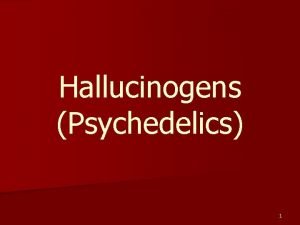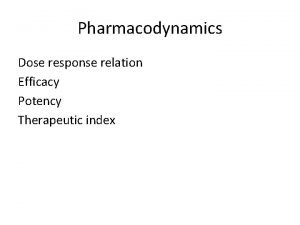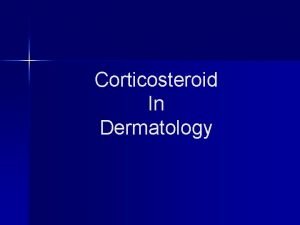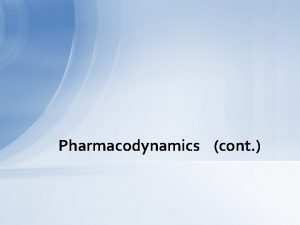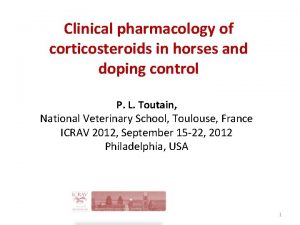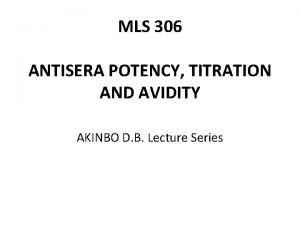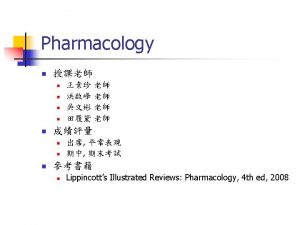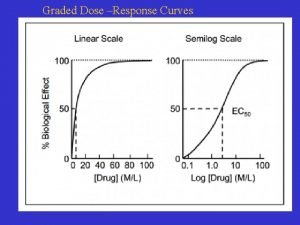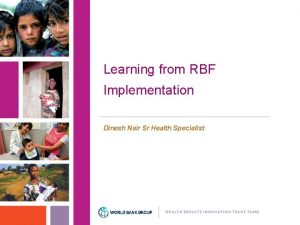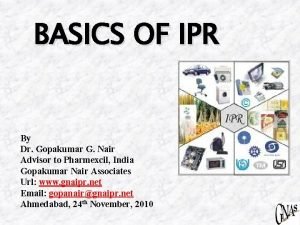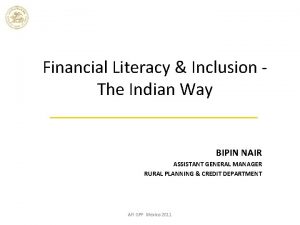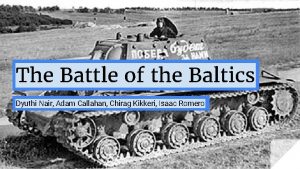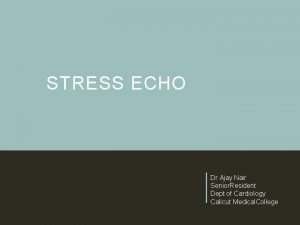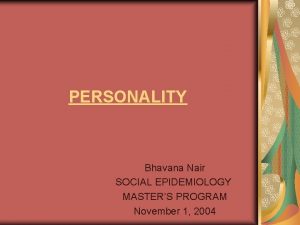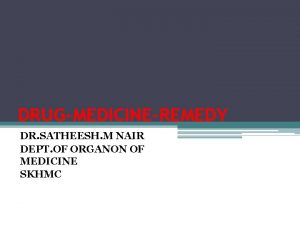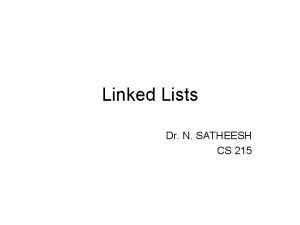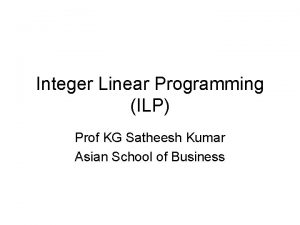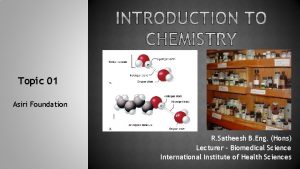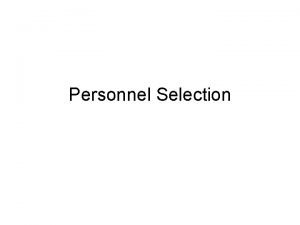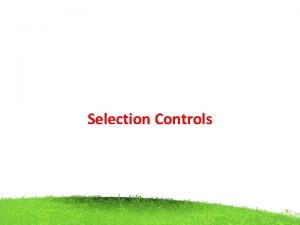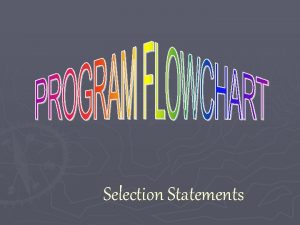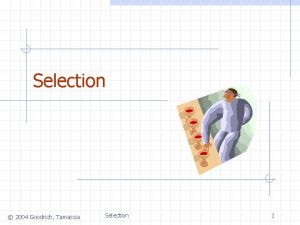SELECTION OF POTENCY Dr SATHEESH M NAIR AIMS



























- Slides: 27

SELECTION OF POTENCY Dr. SATHEESH. M. NAIR

AIMS • What is Potency? • Now a days we are confusing with the selection of Potency – in a case which potency is to be selected ; which potency is cure the case etc, So need a clarification. • Discuss about the criteria for selection of potency.

POTENCY • The resulting products of Trituration and Sucussion is known as potency.

• A disease is may be cured by any potency when indicated remedy is administered, but the cure may be much accelerated by selecting the potency or dose appropriate to the individual case. • For e. g: An artist make many harmony with various vibrations of same chord, but a perfect harmony might be constructed by a proper combination of all the sounds can elicited by his instrument. (Guernsey)

FIVE CONSIDERATIONS FOR SELECTING THE POTENCY 1) 2) 3) 4) 5) The susceptibility of the patient. The seat of the disease. The nature and intensity of the disease. The stage and duration of the disease. The previous treatment of the disease.

SUSCEPTIBILITY OF THE PATIENT What is Susceptibility? �General quality or capability of the living organism of receiving impressions; the power to react to stimuli. �One of the fundamental attributes to life. �Depends all functioning, all vital processes, physiological and pathological. �The cure and alleviation of disease depend upon the same power of the organism to react to the impression of the curative remedy.

• This is the most important guide in the selection of the potency. • The susceptibility of an individual to a remedy at different times also varies. (For e. g. : Idiosyncrasy). • “The more similar the remedy, the more clearly and positively the symptoms of the patient take on the peculiar and characteristic form of the remedy, the greater the susceptibility to that remedy, and higher the potency required. ”

• The mother tinctures and lowest potencies produce common symptoms of the drug. • The medium and high potency produce special and peculiar character of the drug. (Jahr)

• By continual diluting and succussing, remedies get neither stronger or weaker, but their individual peculiarities become more and more developed, their sphere of action is enlarged. • The clearer and more positively the finer, the more peculiar and more characteristic symptoms of the remedy appear in a case, the higher the degree of susceptibility and higher the potency.

• We can judge the degree of susceptibility of the patient by the character and completeness of the symptoms

SUSCEPTIBILITY MODIFIED BY AGE • Susceptibility is greatest in children, young, vigorous persons and diminishes with age. • Children are particularly sensitive during development, most sensitive organs are being developed. • Medicines which have a peculiar affinity for those organs should be given in the medium or high potencies.

SUSCEPTIBILITY IS MODIFIED BY CONSTITUITION AND TEMPERAMENT • Higher potencies for: – Nervous, sanguine or Choleric temperament – Intelligent persons , quick to act and react – Zealous and impulsive persons

• Lower potency and frequent doses: – For Phlegmatic individuals, slow to act – Sluggish individuals – Who possess great muscular power, but need a powerful stimulus to excite them

SUSCEPTIBILITY IS MODIFIED BY HABIT AND ENVIRONMENT • Intellectual occupation, by excitement of imagination and emotions, sedentary occupation, long sleep, an effeminate life – such persons need high potencies.

SUSCEPTIBILITY IS MODIFIED BY PATHOLOGICAL CONDITIONS • In some terminal conditions the power of organism to react is slow even to the indicated Homoeopathic remedy, that only material dose can arouse it. • Grade of the is low, the power of the reaction low, remedy given in low potency, (common, pathological symptoms, organ symptoms correspond to the effect of crude drugs in massive toxic doses) potentized medicines will not act.

• In terminal conditions, when the patient does not react to well selected remedies, nor to intercurrent reaction remedies, given in potentized form and small doses, resort to the crude drug and increase the dose to the point of reaction.

• The remedy given in tincture, or low trituration, first in moderate then increasing doses until the dosage is found to which the patient will react. • The principle of Similia as applied in the selection of both remedy and dose.

SUSCEPTIBILITY IS MODIFIED BY HABIT AND ENVIRONMENT • Low susceptibility : long and severe labor out of doors, who sleep little, whose food is coarse, continual infiuence of drug substance, tobacco workers, dealers, distillers, brewers, druggist, perfumers, chemical workers- possess little susceptibility to medicines and require low potencies (except their illness is directly caused by some particular drug influence, when a high potency of the same or similar drug may prove to be the best antidote. )

• Idiots, imbeciles and the deaf and dumb have a low degree of susceptibility • The persons who are previously taken crude drugs of Allopathic, Homoeopathic or bargaincounter prescription often require higher potencies for their cure- Their susceptibility to crude drugs and low potencies has been exhausted and even massive doses have no effect.

• The seat, character and intensity of the disease has some bearing upon the question of the potency. • Malignant and rapidly fatal disease, like Cholera require material doses or low potencies. (E. g. : of Dr. Hahnemann give Camphor). • Later stages of disease- Higher potencies required.

• Disease is characterized by diminished vital action require lower potencies, while disease characterized by increased vital action respond better to high potencies.

SELECTION OF POTENCY MODIFIED BY TEMPERAMENT AND CONSTITUTIONOF THE PATIENT • Uncomplicated typical Syphilis, in its primary stage, the chancre still being existent may be cured speedily by Mercury in medium or high potencies ( nervous, sanguine temperament). • If he is of sluggish type- Mercury in second or third trituration required.

• Lower potencies should be used in chronic disease with tendency to disorganization of tissues and in acute disease. • High potencies should be used in purely functional and nervous affections.

• If we get a case not at all susceptible to any medicine that time the previous treatment is and regimen taken from patient and avoid medication for few days and control the diet. Then medication may be resumed using, according to the temperament and constitution of patient either a low or medium potency. • Intercurrent remedies (Nosodes). • A single of appropriate nosode in a moderately high potency clear up the case by bringing symptom.

• Study of history of the case and also law of Simila.

CONCLUSION • We must thoroughly about the potencies and dose, because we Homoeopaths, our ultimate aim is bringing cure to a patient. For this we find a similar medicine which is according to the symptom similarity. But the potency is also similar with that condition. Because Individualization is not only for the medicine but also for the potency. We must know the different potencies used in different situations, we diffentiate which potency is accurate for the given case.

Thank you
 Lophophoria
Lophophoria Therapeutic index
Therapeutic index Steroid potency
Steroid potency Ddo quality potency
Ddo quality potency Potency vs efficacy
Potency vs efficacy Beclomathasone
Beclomathasone Potency requirements in an antiserum
Potency requirements in an antiserum Efficacy potency
Efficacy potency Graded response curve
Graded response curve Tgtss
Tgtss Aakash r nair
Aakash r nair Dr dinesh nair
Dr dinesh nair Environmental effects of tidal energy
Environmental effects of tidal energy Who invented nair
Who invented nair In the view of this cartoonist russia under
In the view of this cartoonist russia under Gopakumar g nair
Gopakumar g nair Natasha flyer
Natasha flyer Bipin
Bipin Dyuthi nair
Dyuthi nair Conclusion of wipro company
Conclusion of wipro company Tardokinesis echo
Tardokinesis echo Ajai nair
Ajai nair Moem math
Moem math Bhavana nair
Bhavana nair Gopakumar nair associates
Gopakumar nair associates Artificial selection vs natural selection
Artificial selection vs natural selection Two way selection and multiway selection
Two way selection and multiway selection Example of stabilizing selection
Example of stabilizing selection
